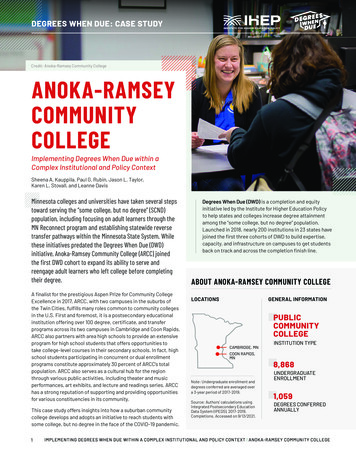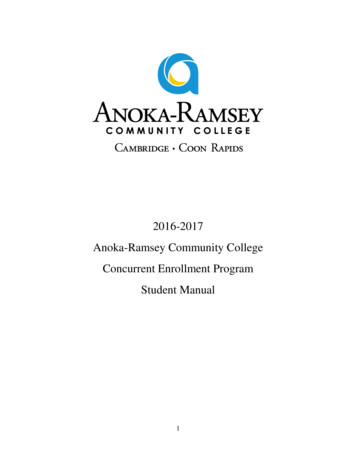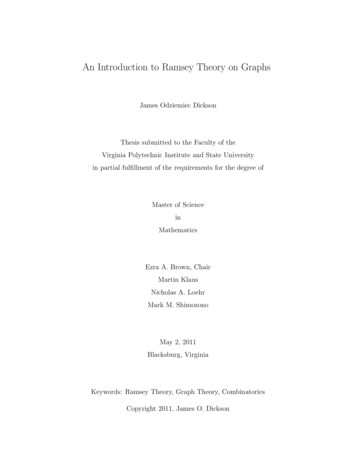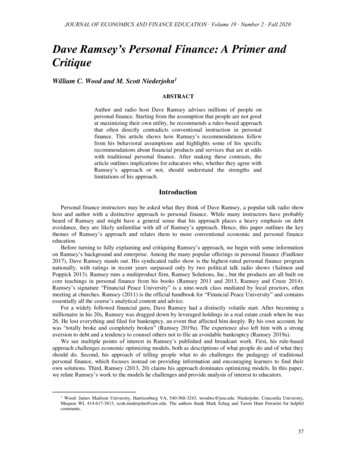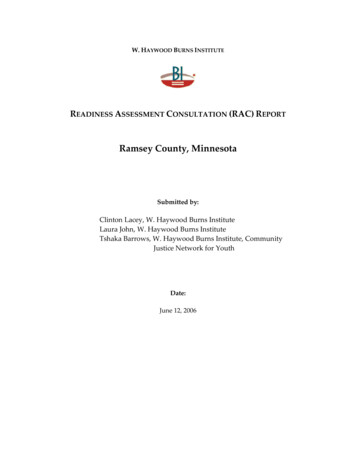
Transcription
W. HAYWOOD BURNS INSTITUTEREADINESS ASSESSMENT CONSULTATION (RAC) REPORTRamsey County, MinnesotaSubmitted by:Clinton Lacey, W. Haywood Burns InstituteLaura John, W. Haywood Burns InstituteTshaka Barrows, W. Haywood Burns Institute, CommunityJustice Network for YouthDate:June 12, 2006
Readiness Assessment Consultation (RAC) ReportTABLE OF CONTENTSPageI. INTRODUCTION2II. METHODOLOGY4A. Evaluation Design . 4B. Data Collection Methods and Sources . 4III. FINDINGS and RECOMMENDATIONSA.B.C.D.E.F.G.6State of DMC .6Purpose of Detention and Detention Utilization .10Community Engagement and Collaboration .16System Stakeholders’ Engagement and Collaboration .18Data Collection and Analysis Capacity 20Current Juvenile Justice Policies and Practices Impact DMC 22Other Factors that Could Affect DMC Reduction Efforts .29IV. SUMMARY of RECOMMENDATIONS301
Readiness Assessment Consultation (RAC) ReportI. INTRODUCTIONThroughout the country, jurisdictions have spent significant time and money trying toreduce racial disparities in their juvenile justice systems with very limited results.Discouraged by a lack of practical approaches that lead to measurable results, mostjurisdictions continue to invest in studies, annual conferences and unsystematicfunding of prevention and intervention programs. These programs may be valuablein their own right, but are not designed or positioned to have any significant impacton disproportionality. Despite the pervasive phenomenon of the overrepresentation ofyouth of color in the nation’s juvenile justice system, the W. Haywood Burns Institutebelieves that reducing the overrepresentation of youth of color in our juvenile justicesystems is an attainable goal.The W. Haywood Burns Institute (BI) is a national organization working with localjurisdictions to reduce the disproportionality of youth of color in the juvenile justicesystem by leading a group of traditional and non‐traditional stakeholders through adata‐driven, consensus‐based process. Disproportionate minority confinement,“DMC” occurs when the proportion of youth of color in a certain community islower than the proportion of youth of color from that community who are confinedin secure detention pre‐adjudication. Over the past decade, many jurisdictions havecome to realize they have a significant problem with DMC in their juvenile justicesystem. Unfortunately, many of those same jurisdictions are overwhelmed by themagnitude and complexity of the problem, and have become frustrated by aseeming lack of viable strategies to work towards DMC reduction.Through its work with many jurisdictions struggling with DMC throughout thenation, BI has recognized a need to engage jurisdictions that are beginning to confrontthe problem and to provide them with a safe space to begin a dialogue about thecommitment and capacity it takes to effectively confront and successfully challengeDMC. For these jurisdictions, Burns Institute has developed a consultation packagewhereby we assess a jurisdiction’s readiness to address DMC. In this ReadinessAssessment Consultation (RAC), BI staff evaluates internal and external factorscontributing to DMC and affecting a jurisdiction’s ability to address DMC.It should be clear that by assessing readiness, we do not assume to predict the actualcommitment a jurisdiction will eventually make nor the course of action it will in facttake to address its DMC issues. Thus, this assessment seeks to provide an objectiveview of the overall juvenile justice policies and practices and how they may beimpacting DMC; and to identify strengths, weaknesses, assets and challenges which2
Readiness Assessment Consultation (RAC) Reportmay enhance or hinder the jurisdiction’s ability to engage in an effective DMCreduction initiative.It should also be clear that the Readiness Assessment is not intended to provide an in‐depth analysis of Ramsey County’s juvenile justice system, nor is it the result of acomprehensive research project. Further, it is not written to express the particularopinions of Burns Institute staff. This assessment is, rather, the Burns Institute’sinterpretation of the data, information and views provided by Ramsey stakeholdersthemselves; and is intended to provide insight on possible contributors to DMC, withthe ultimate objective of developing viable solutions to the problem.We appreciate the cooperation and participation of everyone involved with the RACin Ramsey County. We found the stakeholders to be generous with their time andforthcoming with their observations.3
Readiness Assessment Consultation (RAC) ReportII.METHODOLOGY and DATA SOURCESThis chapter describes the overall approach to conducting the Readiness AssessmentConsultation (RAC) in Ramsey County. The RAC was developed by the BurnsInstitute Staff in collaboration with the Institute for Social and Environmental JusticeEducation.A. Evaluation DesignThe purpose of this RAC in Ramsey County was to assess the current state of DMCand identify factors influencing progress in Ramsey County’s ability to successfullyaddress DMC. The following evaluation goals were established:1) Assess and document the state and extent of DMC in Ramsey County.2) Assess and document how the following impact Ramsey’s ability to address DMC:a. Purpose of detention and detention utilization;b. Community engagement and collaboration;c. System Stakeholders’ engagement and collaborationd. Data collection and analysis capacity; ande. Current juvenile justice policies and practices.3) Identify any Other Factors that Could Affect DMC Reduction Efforts.B. Data Collection and Analysis1) Interviews.From February 27 through March 1, BI staff interviewed key stakeholders in RamseyCounty’s juvenile justice system. Stakeholders included representatives fromRamsey County Community Corrections Department, Saint Paul Police Department,Second Judicial District, Ramsey County Attorneys Office; Public Defenders Office;Saint Paul Public Schools; Ramsey County Board of Commissioners; CourtAdministration; and representatives from various community based organizationsin Ramsey County including the YWCA, Hmong American Partnership; CollectiveCommunities for Hope; Save our Sons; Workforce Solutions; and Northwest Youthand Family Services.Most interviews were conducted with individual representatives from the agenciesand organizations listed above, and some interviews were conducted in groups. Aforum with several representatives from community based organizations working4
Readiness Assessment Consultation (RAC) Reportwith youth. The interviews ranged in length from 60 to 120 minutes. A full listingof the questions asked of key stakeholders is available upon request.2) Document Review.The following documents were obtained and consulted in the course of theassessment:(1) JDC Admissions Data for Pre‐Adjudicated Youth (2004‐2005);(2) JDC Admissions Data for Youth Admitted to 7,14, and 30 Day WorkPrograms;(3) Summary Information on Juvenile Delinquency Petitions in MinnesotaCourts (March 2005);(4) Ramsey County Community Corrections (2003 Annual Report);(5) Ramsey County Community Corrections (2004 Annual Report); and(6) Minnesota’s Juvenile Code, §§ 260B.001 ‐ 260B.446 of Chapter 260Juveniles.5
Readiness Assessment Consultation (RAC) ReportIII.FINDINGS and RECOMMENDATIONSChapter Three discusses the Burns Institutes findings and recommendations. It isorganized into seven sections:A.B.C.D.E.F.G.State of DMC;Purpose of Detention and Detention Utilization;Community Engagement and Collaboration;System Stakeholders’ Engagement and Collaboration;Data Collection and Analysis Capacity;Current Juvenile Justice Policies and Practices Impact DMC; andOther Factors that Could Affect DMC Reduction Efforts.Within each of the sections, recommendations are offered. Additionally, a summary ofall recommendations is provided in Chapter Four.A. State of DMC in Ramsey County1. General DMC KnowledgeA key component to being ready to challenge DMC is to understand what “DMC” is andto identify whether and to what extent DMC exists in the juvenile justice system.Juvenile justice stakeholders in Ramsey County have a basic understanding of what“DMC” is, and many system stakeholders articulated how their role in juvenile justicecould impact DMC. However, several stakeholders expressed confusion and differingperspectives as to what DMC reduction efforts should focus on. Some thought efforts toaddress DMC should focus exclusively on “confinement” of a disproportionate numberof youth of color in JDC pre‐adjudication. Others favored broader efforts to prevent“risky” behaviors among youth of color before they get entrenched in the juvenile justicesystem. For many stakeholders, the latter view point focused on the apparent pathologyof poor communities of color and a sense that the youth therein are dysfunctional.Regardless of how DMC was defined, all stakeholders interviewed acknowledged thatdisproportionality of youth of color in the juvenile justice system is a problem in RamseyCounty. However, stakeholders did not have a clear sense of the extent to whichdisproportionality exists in Ramsey County, nor where the disproportionality occurredwithin the juvenile justice system.2. Efforts to Reduce DMCStakeholders indicated that there have been discussions about how to challenge DMCfor several years, but to date there has been no action plan initiated. The recentconvening of a Steering Committee to address juvenile detention reform efforts, and6
Readiness Assessment Consultation (RAC) ReportDMC specifically is charged with turning a superficial and theoretical discussion ofDMC into a strategic action plan. Several stakeholders expressed a commitment to thedevelopment and implementation of a broad range of evidenced‐based practices inRamsey. We believe that such a commitment could be a huge asset to stakeholders asthey launch efforts to reduce DMC.3. Analysis of Current Juvenile Detention Center DMCAccording to 2004 and 2005 data, African American youth are over‐represented in pre‐adjudication admissions to secure detention at Ramsey County JDC. In 2004 African Americanyouth represented 14% of the overall youth population in Ramsey County 1 , but 46% and 50% ofyouth admitted to detention pre‐adjudication in 2004 and 2005, respectively.Figure 1: Illustration of overrepresentation of Youth of Color in Ramsey County Detention AdmissionsRamsey County:Ramsey County: Admissions toRamsey County: Admissions toOverall Youth Population (2004)Detention Pre‐Adjudication (2004)Detention Pre‐Adjudication (2005)1%18%4%7%14%White29%7%60%African AmericanLatinoAsianNative American27%8%46%White3%12%14%50%African AmericanLatinoAsianNative AmericanWhiteAfrican AmericanLatinoAsianNative AmericanSource: JDC Data Reports (2004-2005). Note that percentage includes duplicate counts.African American youth are also over‐represented in admission to Ramsey County’s WorkProgram, a program within Ramsey JDC (to be discussed in greater detail in the sections thatfollow). African American youth represented 14% of the overall youth population in RamseyCounty, but 43% and 51% of admissions to the work program in 2004 and 2005, respectively.Figure 2: Illustration of overrepresentation of Youth of Color in Work ProgramsRamsey County:Ramsey County: TotalRamsey County: Total Admissions toOverall Youth Population (2004)Admissions to Work Program (2004)Work Program (2005)18%1%3%14%14%African AmericanAsianNative hiteAsianAfrican AmericanNative AmericanLatinoUnknownWhiteAsianAfrican AmericanNative AmericanLatinoOther/UnknownSource: JDC Data Reports (2004-2005). Note that percentage includes duplicate counts.1Puzzanchera, C., Finnegan, T. and Kang, W. (2006). "Easy Access to Juvenile Populations" Online. Available online:http://www.ojjdp.ncjrs.org/ojstatbb/ezapop/ Ramsey County, Minnesota: Race by Ethnicity Population Estimates, 2004 (age 10-17).7
Readiness Assessment Consultation (RAC) Report4. Identification of Subpopulations Most Impacted by DMCSeveral stakeholders indicated that they believed a significant number of youth of colorcurrently detained at JDC reside inFigure 3: Zip Codes With Highest Admissions to JDCthe neighborhoods of “Frogtown”Zip Codes with Highest Number of Admissions to JDC (2005)and the “East Side.” An initial286300analysis of the 2005 JDC211admissions to detention confirms200this belief. Figure 3 represents1199281those zip codes that admitted the100464656463017highest number of youth to JDC in802005. As Figure 3 indicates, East551065510455117Side (zip code 55106) andWhite African American Latino AsianFrogtown (zip code 55104)Source: JDC Data (2005). Total Admissions to detention in 2005 3310 (White 865;contribute most significantly toAfrican American 1620; Latino 275; Asian and SE Asian 400; NativeAmerican 86; Other 64).youth of color in detention.While stakeholders were able to identify the neighborhoods that contributed most significantly tothe detention population, few stakeholders could identify why those neighborhoods arecontributing high number of detention admissions. Some stakeholders posited that strong lawenforcement presence in these communities contributed to detention admissions, while otherstakeholders reflected on the apparent pathology and dysfunction of poor communities of color.Few stakeholders were able to identify the qualities and services within these communities thatcould be strengthened to reduce DMC.Recommendations Regarding Knowledge of DMC and Efforts to Reduce DMC1. The newly convened Steering Committee and DMC Collaborative mustclarify how it defines and identifies DMC in Ramsey County beforemaking efforts to address the problems impacting and related to DMC.2. The Steering Committee and DMC Collaborative should continue itscommitment to using evidence‐based practices to guide DMC reductionefforts.3. All relevant Ramsey County stakeholders should employ an analysiswhich takes a deeper look at a range of possible systemic causes anddrivers of DMC.4. To ensure that all stakeholders have a clear understanding ofdisproportionality in the system, consistent detention data must be madeavailable to all key stakeholders. The DMC Collaborative shouldimplement an ongoing process of DMC data collection, tracking andanalysis. This analysis should focus on policies and practices that may be8
Readiness Assessment Consultation (RAC) Reportcontributing to DMC at key decision points in the juvenile justicecontinuum.5. The Steering Committee and DMC Collaborative should investigate andidentify services and organizations that are currently thriving in theneighborhoods most impacted by DMC. As well, stakeholders shouldinvestigate both the current and potential capacity of those communitybased organizations to collaborate with the juvenile justices system onsuch initiatives as alternative to detention programs. Utilization ofalternatives to detention in communities that contribute largely todetention can be a vital component of a DMC reduction initiative. AsFigure 3 indicates, Frogtown and East Side, communities that contributesignificantly to youth of color in detention, may be communities to target.6. According to initial data analysis conducted by BI, African Americanyouth are clearly overrepresented in Ramsey JDC, both in pre‐adjudication admissions and admissions to the Work Program. While itdoes not appear that Asian youth are overrepresented, severalstakeholders identified a history of Hmong youth being overrepresentedin detention, so further analysis of the “Asian” population is required.9
Readiness Assessment Consultation (RAC) ReportB. Purpose of Detention and Detention UtilizationA key component to being ready to confront disproportionality in juvenile detentionfacilities requires stakeholders to come to a general consensus as to the purpose ofdetention. If stakeholders disagree as to why youth should be held in juvenile detentionfacilities, there will be inconsistent decision making by stakeholders as youth areprocessed through the system.Unlike many juvenile detention facilities which serve solely as a secure detentionfacility, the Ramsey Juvenile Detention Center (JDC) currently serves three functions.JDC houses not only pre‐adjudication youth and youth awaiting placement, but alsoyouth in the “Short‐Term Work Program” a short‐term consequence low risk offendersand a sexual offender program, Sexual Treatment through Accountability andResponsibility for Teens (“START”) 2 .The multiple functions of JDC as a detention facility, a sanction, and a rehabilitationcenter creates confusion among stakeholders as to the purpose of detention.Additionally, there is a fundamental disagreement among stakeholders as to whetherthere is merit in utilizing detention as consequence, or whether detention should be usedas a last‐ditch solution for youth who pose a significant safety or flight risk. As oneinterviewee said, “it is going to be a struggle for some (stakeholders) to get over thementality that kids need detention.”A consistent observation emerged that the juvenile justice system was being loadeddown with inappropriate referrals. Not unlike many jurisdictions throughout thecountry, Ramsey County has a propensity to place “high need” but “low risk” youth inJDC simply due to a lack of viable options and alternatives that serve these youth. Whenlow risk youth are detained by default, as a punishment or to connect them to services,the over representation of youth of color may increase.“START” is a 12 bed program that provides intensive residential sex offender treatment for malescommitted by the Court. An assessment of this rehabilitation program is beyond the scope of thisassessment regarding readiness for DMC action, but our observations call into question whether JDC, adetention facility built for the purpose of short term holds, is an appropriate venue for a long‐termrehabilitation center.210
Readiness Assessment Consultation (RAC) Report1. Ramsey County Juvenile Detention Center as DetentionAccording to Statute, juvenilesFigure 4 : Charges Resulting in Pre-Adjudication Detentiontaken into custody in MinnesotaThree Charges Most Frequently Resulting in Pre‐Adjudication Detention (2005)may not be detained unless they400are a danger to themselves or327278300others; to ensure their177179200appearance at subsequent141686360hearings; if they are a risk to flee;5010039275525133or if their immediate health or0welfare is immediatelyPROBATION VIOLATIONWARRANTISP WAIVERendangered 3 . Based on an initialWhiteAfrican American LatinoAsian Native Americananalysis of youth admitted toSource: JDC Data 2005. Total Admissions to detention in 2005 3310 (White 865; African AmericanJDC in 2005, it appears that 1620; Latino 275; Asian and SE Asian 400; Native American 86; Other 64)admissions to JDC often extendbeyond these parameters, particularly for youth of color.As the Figure 4 indicates, a high number of admissions to JDC as “detention” are the result oftechnical violations rather than criminalFigure 5: African American Admissions to Detentionoffenses. The charges most frequentlyAdmissions to Detention for African American youthresulting in pre‐adjudication admissions to(2004‐2005 comparison)detention in 2005 included Probation400327278265Violations, Warrants 4 , and ISP Waivers.300235These three offenses accounted for 1,532 or20014113946.3% of the total 3,310 admissions to100detention in 2005. The high percentage of0PROBATIONWARRANTIS P WAIVERadmissions to detention for these threeV IOLATIONoffenses also held true for African20042005American youth. For African AmericanSource: JDC Data (2004-2005)youth, Probation Violations, Warrants, andISP Waivers in 2005 accounted for 746 or 46% of the total 1,620 African American admissions todetention 5 . Additionally, as Figure 5 indicates, it appears that detention utilization for ProbationViolations and Warrants increased for African American youth from 2004 to 2005.Further data analysis will indicate more precisely the extent to which DMC is being impactedby the current detention utilization practices, but our initial examination indicates that theimpact is significant.3Minn. Stat. § 260B.176, Subd. 1 (2004).To be sure, a more in depth analysis as to the reasons for the high number of warrants in Ramsey County is necessary. According tointerviewees, a significant number of youth in detention due to a warrant are the results of failures to appear. A policy which featurethe automatic detention of youth with warrants results in the detention of significant numbers of no and low risk youth; and thus,contributes to DMC. A more in depth investigation into whether this is true will guide strategies to reduce DMC based on warrants.5It should be noted that Figure 4 does not include those youth from racial/ethnic groups that represent 1% or less of the total detentionpopulation.411
Readiness Assessment Consultation (RAC) ReportIllustration of the Need for Consensus around the Purpose of Detention:Analysis of Youth Released from JDC within 36 hours.An analysis of youth released from detention within 36 hours serves to demonstrate why consensus aroundthe purpose of detention is essential to Ramsey County’s ability to reduce DMC.In Minnesota, youth may not be detained in juvenile detention facilities for longer than 36 hours unless apetition has been filed and a judge determines that the child must remain in detention 6 . One way to probewhether there is consensus as to theFigure 6: Youth Released Within 36 Hourspurpose of detention is to query theYouth Released within 36 Hoursnumber of youth released within 361500hours at their detention hearing. Intheory, if there is consensus as to the1000873purpose of detention, then a very small589percentage of youth should be released500280at their detention hearing/arraignment.14047528876148In other words, if the agencies and07230WhiteAfrican AmericanLatinoAsianNative Americandepartments who referred and admittedReleased within 36 HoursHeld Longer than 36 Hoursyouth to JDC have the same perceptionSource:JDCData(2004)of the purpose of detention as the judgewho has the authority to release ordetain the same youth within 36 hours, then a small number of youth will be released within 36 hours.Data for youth released from JDC within 36 hours was available for 2004. In 2004, of a total 2,971 youthadmitted to detention, 1,013, or 34%, were released within 36 hours. Of the 1,013 youth released within 36hours, 72% or 725 youth were youth of color. This means that 725 youth of color admitted to JDC in 2004 mayhave been inappropriately detained because there was not clarity between referring agencies and the bench asto the purpose of detention.Based on the high number of youth released within 36 hours, there appears to be a disconnect between thestandards used by those agencies and departments referring and admitting youth to detention pre‐adjudication and the standards used by the bench at the detention hearing to determine whether or notdetention is appropriate. This disconnect contributes to unnecessary detention and disproportionality.It seems then that a significant number of youth could avoid detention if there was consensus as to whichyouth should be detained at JDC. The 725 youth of color held for 36 hours or less could be spared time spent indetention if youth released within 36 hours of admission to detention were never brought to detention in thefirst place. Thus, consensus among referring agencies and the bench as to the purpose and use of detentioncould go far to significantly reduce the youth of color in detention.6Minn. Stat. § 260B.176, Subd. 2 (2004).12
Readiness Assessment Consultation (RAC) ReportRecommendations on the Purpose of Detention1. The Steering Committee and DMC Collaborative must engage in ameaningful conversation focused on the purpose of detention. Such adiscussion will lead to a process of teasing out those youth referred andadmitted to JDC when detention is unnecessary.2. A more in depth investigation into what offenses and other factors youthreleased within 36 hours have in common, so there can be a targetedeffort to keep these youth out of detention in the first place. For example,as figure 6 indicates 725 youth of color were released within 36 hours oftheir admission to detention. The Steering Committee must engage in adiscussion to find out why these youth were detained.2. Ramsey County Juvenile Detention Center as a “Work Program”According to Ramsey Community Corrections, the “Work Program” was established to“fill a crucial need for short‐term, out of home interventions that are consequenceoriented for less serious offenders. 7 ” There are three time lengths for the workprograms, 7/11, 14/21, and 30/45 days respectively. For example, if the Court gives adisposition of a 7/11, a resident may “earn” a release after seven days if he or shesatisfied all of the work program requirements. If the youth does not meet the programrequirements, he or she may be required to serve all eleven days. A behaviormodification system is used to score each participating youth’s conduct andachievements each hour of the day. The youth have an expectation to “performmeaningful and productive work,” and the program intends to “teaches the importanceof personal responsibility and having good work ethic.” 8 It should be noted that otherRamsey stakeholders, both within the juvenile justice system and from the community,expressed a different view of the work program. They questioned the purpose, valueand effectiveness of the work program and expressed views that it is a misuse ofdetention and falls short of providing meaningful and productive work for itsparticipants.Research contradicts the value of using detention as a consequence. A substantial bodyof research indicates detention as punishment does nothing to reduce recidivism and infact, has negative effects on those youth consigned. Common reasons for such negativeeffects are: The inherent inadequacy of in custody service delivery (even in well run facilities); negative interaction between low risk and high risk children in custody; threats to physical and emotional well being; and the separation of the child from family and familiar community.78Ramsey County Community Corrections Annual Report (2003).Ramsey County Community Corrections Annual Report (2004-2005).13
Readiness Assessment Consultation (RAC) ReportThe majority of youth admitted to the work program are youth of color. Refer back toFigure 2 on page 7. According to Figure 2, in 2005 77% of youth admitted to the workprogram were youth of color.The high representation of youth of color in the work program appears to stem largelyfrom youth admitted to the work program as a result of a probation violation. As Figure7 indicates, in 2005, 638Figure 7: JDC Work Program Admissionsyouth were admitted to the2005 Total Admissions to JDC Work ProgramWork Program 9 . Overall,40076% of youth admitted to the work program as a362 or 57% youth were300result of a probation violation are youth of color.134admitted to the Work200Program as the result of a651001922738Probation Violation. What1288399034is more, 76% of those youthWhiteAfrican AmericanLatinoAs ianNative Americanadmitted to the workProbation Violation All other Offensesprogram as a result of aSource: JDC Data (2005).probation violation are youthof color.Few Ramsey Stakeholders could recall the impetus for initiating the Work Program.Whatever the impetus, though, the Program is now heavily relied upon by Probation,and the Courts. According to some Ramsey County stakeholders, the reason for thecurrent reliance on the program is rooted in philosophical ideology that shockincarceration has merit. Thus, the program is now embedded in the dispositionaloptions for youth in violation of the law or probation.As well, it was noted by several Stakeholders that there are there are discrepanciesamong the probation officers as to the utility of detention as a “pound of flesh.” SeveralStakeholders noted that some Probation Officers over‐utilize the program “to get thekids attention.” The Courts indicate that when they have to make flash decision, theyusually default to the Probation recommendation. The Burns Institute believes that th istendency to default to such recomm endations may further exacerbate the overuse ofd etention and contribute to DMC.9It should be noted that Figure 7 does not include those youth from racial/ethnic groups that represent 1% or less of the totaldetention population.14
Readiness Assessment Consultation (RAC) ReportRecommendations Regarding Work Program1. The Steering Committee and DMC Collaborative should engage in ameaningful discussion around the problems associated with the workprogram and the high number of youth of color admitted to it.2. The Steering Committee and DMC Collaborative should re‐consider thecounty’s use of detention and develop more dispositional alternatives,particularly for violations of probation. As Figure 7 indicates, 76% ofyouth admitted to the work program as a result of a probation violationare youth of color. Perhaps if dispositional alternatives were available,this number could decrease.15
Readiness Assessment Consultation (RAC) ReportC. Community Engagement and CollaborationTo effectively address DMC the active participation of community leaders from theneighborhoods most affected is essential as they bring information and knowledgeabout the community to the table. There are several community leaders in RamseyCounty that are very concerned about DMC and when interviewed expressed interest inefforts to address it.The community leaders describe their history and experience interacting with thejuvenile justice system and belie
(4) Ramsey County Community Corrections (2003 Annual Report); (5) Ramsey County Community Corrections (2004 Annual Report); and (6) Minnesota's Juvenile Code, §§ 260B.001 ‐ 260B.446 of Chapter 260 Juveniles.


